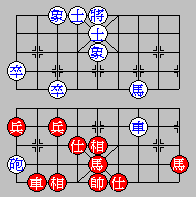Perpetual chasing in Xiangqi
Posted: Tue Jul 13, 2010 8:41 am
In Xiangqi it is not allowed to force the opponent into repetition. So like in Chess, after the same position repeats for the 3rd time, the game can be claimed. But unlike Chess, the result is not always a draw. If, all the moves between the current position and the one two occurrences before were forcing moves, that side loses!
Now exactly which moves are forcing, and which not, depends on the local rules. Checks are considered forcing under any rule set, so perpetual checking is always forbidden. But on threatening mate-in-1, or threatening to gain material through deep tactic, like a skewer ("check and capture"), the rules differ. In "China mainland rule" all this is forbidden, making these rules practically unimplementable. Computer Xiangqi therefore usually follows Asia rules, which are highly simplified. Basically in Asia rules, only making a direct attack on a piece will be considered a forcing move. Mate threats, or material gains after an exchange of multiple moves does not count. Forcing moves that are not checks are referred to as chases.
Even with that simplification, Asia rules are highly complex. In the official description, 104 example diagrams are given of perpetual chases, or repeats that are not to be considered chases (and thus draws). The following set of rules seems to cover all these 104 cases, though:
Now exactly which moves are forcing, and which not, depends on the local rules. Checks are considered forcing under any rule set, so perpetual checking is always forbidden. But on threatening mate-in-1, or threatening to gain material through deep tactic, like a skewer ("check and capture"), the rules differ. In "China mainland rule" all this is forbidden, making these rules practically unimplementable. Computer Xiangqi therefore usually follows Asia rules, which are highly simplified. Basically in Asia rules, only making a direct attack on a piece will be considered a forcing move. Mate threats, or material gains after an exchange of multiple moves does not count. Forcing moves that are not checks are referred to as chases.
Even with that simplification, Asia rules are highly complex. In the official description, 104 example diagrams are given of perpetual chases, or repeats that are not to be considered chases (and thus draws). The following set of rules seems to cover all these 104 cases, though:
These are the rules according to which WinBoard adjudicates repetitive Xiangqi games. This thread was created to discuss cases where this might lead to controversion (or wrong) adjudications.Asia rule wrote:1) Checking is considers a worse offence than chasing another piece. So if one side is perpetually checking, and the other is perpetually chasing, the checking side loses. All chases are equal, though: if one side perpetually chases a Rook, and the other a Pawn, it is draw.
2) To make a forbidden perpetual chase, you must really chase the same piece on every move of the repeat cycle. (And it does not matter which piece does the chasing: two (or multiple) pieces taking turns to chase one is still forbidden. ) Having a single non-forcing move in the cycle ("one check, one idle", "one chase, one idle") completely acquits you of chase charges. Also alternately chasing two different pieces (including "one check, one chase") is allowed.
3) A chase must be a _new_ attack on a piece. If you could already capture piece A with piece B before move M, then being able to capture A with B after M does not threaten anything new, and is not a chase. E.g. moving a Rook along the attack ray is not creating a new attack. (Checks, obviously, always are new.) Note that one move can result in mutiple chases, both on multiple targets, (e.g. forks) and by multiple perpetrators (e.g. discovered attacks). They all must be judged separately.
4) A newly created attack is in general only considered forcing (i.e. a chase) if the target is not protected. If it can be recaptured on the same square, the attack is not a chase. (Note that the possibility to recapture might depend on how the piece is captured, in case of multiple attackers, so this has to be judged per (attacker, victim)-pair, and is not an intrinsic property of the victim.) But there are some exceptions that are declared either always a chase or never a chase, irrespective of the protected status of the victim:
- Attacks of Horse or Cannon on Rook are always a chase
- Attacks on a Pawn that has not crossed the River are never a chase
- Attacks by a Pawn or King are never a chase
- Attacks on a King are of course always checks
5) An attack on a piece is also not considered a chase if the piece can capture its attacker (which must be of equal type) back. The possibility for such pre-emptive self-defence is considered as good as having a protector that can retaliate. Such attacks are called "sacrifices" or "offers to exchange", not chases. Note that it does not matter if you can pre-emptively capture the attacker with another piece than the chased one, or if the chase victim can capture a piece other than the one chasing it.
6) In all cases only legal moves are taken under consideration. Pseudo-legal captures that are not legal are to be completely ignored. This applies to the attacks itself, to recaptures by a protector, or to pre-emptive counter captures. On the other hand, if the move is legal, does not have to be a good one. Even if it gets you mated in one after making it, or loses you heavy material, the move should be taken into account. (E.g. when a piece is twice attacked, and only once protected, recapturing might be suicidal, but the piece still counts as protected.)


